Related Research Articles
Antioxidants are compounds that inhibit oxidation, a chemical reaction that can produce free radicals. Autoxidation leads to degradation of organic compounds, including living matter. Antioxidants are frequently added to industrial products, such as polymers, fuels, and lubricants, to extend their usable lifetimes. Foods are also treated with antioxidants to forestall spoilage, in particular the rancidification of oils and fats. In cells, antioxidants such as glutathione, mycothiol, or bacillithiol, and enzyme systems like superoxide dismutase, can prevent damage from oxidative stress.

Leishmania is a parasitic protozoan, a single-celled organism of the genus Leishmania that is responsible for the disease leishmaniasis. They are spread by sandflies of the genus Phlebotomus in the Old World, and of the genus Lutzomyia in the New World. At least 93 sandfly species are proven or probable vectors worldwide. Their primary hosts are vertebrates; Leishmania commonly infects hyraxes, canids, rodents, and humans.
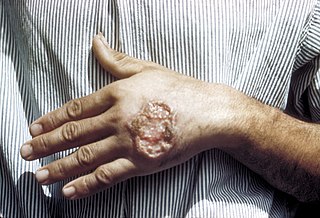
Leishmaniasis is a wide array of clinical manifestations caused by protozoal parasites of the Trypanosomatida genus Leishmania. It is generally spread through the bite of phlebotomine sandflies, Phlebotomus and Lutzomyia, and occurs most frequently in the tropics and sub-tropics of Africa, Asia, the Americas, and southern Europe. The disease can present in three main ways: cutaneous, mucocutaneous, or visceral. The cutaneous form presents with skin ulcers, while the mucocutaneous form presents with ulcers of the skin, mouth, and nose. The visceral form starts with skin ulcers and later presents with fever, low red blood cell count, and enlarged spleen and liver.

Neisseria is a large genus of bacteria that colonize the mucosal surfaces of many animals. Of the 11 species that colonize humans, only two are pathogens, N. meningitidis and N. gonorrhoeae.
Mauritian Creoles are the people on the island of Mauritius and in the wider overseas Mauritian diaspora who trace their roots to Black Africans who were brought to Mauritius under slavery from the seventeenth to the nineteenth century. It can also refer to and include members of the island's mixed race or Métis community, especially if they are Christian. In government records, creoles along with Franco-Mauritians form part of the broader group known as Population Générale.
Ophthalmic acid (OPH), also known as ophthalmate (chemically L-γ-glutamyl-L-α-aminobutyrylglycine), is a tripeptide analog of glutathione. However, instead of the cysteine essential for many of glutathione's diverse functions, it contains L-2-aminobutyrate, a non-proteinogenic amino acid lacking the nucleophilic thiol group. Because of this, it has been widely, and incorrectly, considered an accidental byproduct of glutathione synthesis.
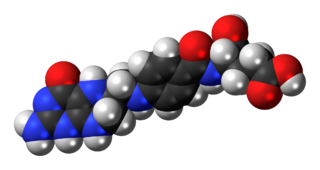
Tetrahydrofolic acid (THFA), or tetrahydrofolate, is a folic acid derivative.

Ganoderma orbiforme – most commonly known as G. boninense or just Ganoderma in oil palm pathology – is a species of polypore fungus that is widespread across southeast Asia. It is a plant pathogen that causes basal stem rot, a disease of the African oil palm. The fungus was first described scientifically in 1838 by Elias Magnus Fries from collections made in Guinea. Leif Ryvarden transferred it to the genus Ganoderma in 2000. In addition to its type locality, the fungus has also been collected from the Bonin Islands in the Pacific, and from Venezuela and Puerto Rico.
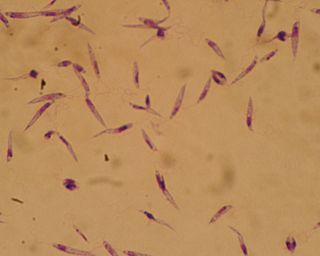
Leishmania major is a species of parasite found in the genus Leishmania, and is associated with the disease zoonotic cutaneous leishmaniasis. L. major is an intracellular pathogen which infects the macrophages and dendritic cells of the immune system. Though Leishmania species are found on every continent aside from Antarctica, Leishmania major is found only in the Eastern Hemisphere, specifically in Northern Africa, the Middle East, Northwestern China, and Northwestern India.

Glutathione peroxidase 4, also known as GPX4, is an enzyme that in humans is encoded by the GPX4 gene. GPX4 is a phospholipid hydroperoxidase that protects cells against membrane lipid peroxidation.
Small activating Ribonucleic acids (saRNAs) are small double-stranded RNAs (dsRNAs) that target gene promoters to induce transcriptional gene activation in a process known as RNA activation (RNAa).

Leishmania donovani is a species of intracellular parasites belonging to the genus Leishmania, a group of haemoflagellate kinetoplastids that cause the disease leishmaniasis. It is a human blood parasite responsible for visceral leishmaniasis or kala-azar, the most severe form of leishmaniasis. It infects the mononuclear phagocyte system including spleen, liver and bone marrow. Infection is transmitted by species of sandfly belonging to the genus Phlebotomus in Old World and Lutzomyia in New World. The species complex it represents is prevalent throughout tropical and temperate regions including Africa, China, India, Nepal, southern Europe, Russia and South America. The species complex is responsible for thousands of deaths every year and has spread to 88 countries, with 350 million people at constant risk of infection and 0.5 million new cases in a year.
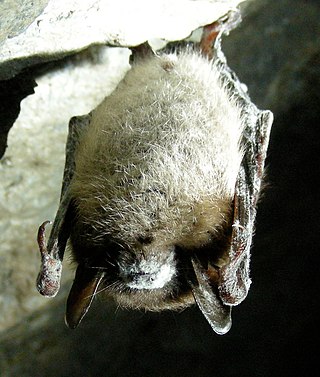
Pseudogymnoascus destructans is a psychrophilic (cold-loving) fungus that causes white-nose syndrome (WNS), a fatal disease that has devastated bat populations in parts of the United States and Canada. Unlike species of Geomyces, P. destructans forms asymmetrically curved conidia. Pseudogymnoascus destructans grows very slowly on artificial media and cannot grow at temperatures above 20 °C. It can grow around 4 °C to 20 °C, which encompasses the temperatures found in winter bat hibernacula. Phylogenic evaluation has revealed this organism should be reclassified under the family Pseudeurotiaceae, changing its name to Pseudogymnoascus destructans.
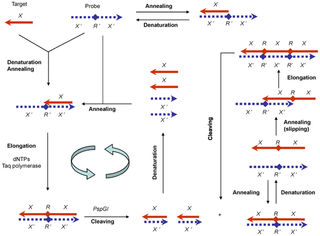
Polymerase-endonuclease amplification reaction (PEAR) is a DNA amplification technology for the amplification of oligonucleotides. A target oligonucleotide and a tandem repeated antisense probe are subjected to repeated cycles of denaturing, annealing, elongation and cleaving, in which thermostable DNA polymerase elongation and strand slipping generate duplex tandem repeats, and thermostable endonuclease (PspGI) cleavage releases monomeric duplex oligonucleotides.
The bacterial stress response enables bacteria to survive adverse and fluctuating conditions in their immediate surroundings. Various bacterial mechanisms recognize different environmental changes and mount an appropriate response. A bacterial cell can react simultaneously to a wide variety of stresses and the various stress response systems interact with each other by a complex of global regulatory networks.
In molecular biology mir-398 microRNA is a short RNA molecule. MicroRNAs function to regulate the expression levels of other genes by several mechanisms.
Suvendra Nath Bhattacharyya is an Indian molecular biologist, epigeneticist and the principal scientist at the Indian Institute of Chemical Biology of the Council of Scientific and Industrial Research. He is a recipient of the Swarnajayanthi Fellowship of the Department of Science and Technology and the National Bioscience Award of the Department of Biotechnology. The Council of Scientific and Industrial Research, the apex agency of the Government of India for scientific research, awarded him the Shanti Swarup Bhatnagar Prize for Science and Technology, one of the highest Indian science awards, in 2016, for his contributions to biological sciences.
Ravishankar Ramachandran is an Indian molecular biologist and a senior principal scientist at the department of molecular and structural biology of the Central Drug Research Institute. Known for his studies on the molecular mechanisms of human pathogens such as Mycobacterium tuberculosis, Ramachandran is a DBT-nominated member of the Institutional Bio-Safety Committee of Babasaheb Bhimrao Ambedkar University. His studies have been documented by way of a number of articles and ResearchGate, an online repository of scientific articles has listed 142 of them. The Department of Biotechnology of the Government of India awarded him the National Bioscience Award for Career Development, one of the highest Indian science awards, for his contributions to biosciences, in 2010.
Debasis Dash is an Indian computational biologist and chief scientist at the Institute of Genomics and Integrative Biology (IGIB). Known for his research on proteomics and Big Data and Artificial Intelligence studies, his studies have been documented by way of a number of articles and ResearchGate, an online repository of scientific articles has listed 120 of them. The Department of Biotechnology of the Government of India awarded him the National Bioscience Award for Career Development, one of the highest Indian science awards, for his contributions to biosciences, in 2014. He was appointed as the director of Institute of Life Sciences, Bhubaneswar on 18 May 2023.
Manoj Majee is an Indian plant molecular biologist, biochemist, inventor and a senior scientist at the National Institute of Plant Genome Research (NIPGR), New Delhi. He is known for his studies on the molecular and biochemical basis of seed vigor, longevity and seedling establishment.
References
- ↑ "Subrata Adak on IICB". iicb.res.in. 1 February 2018. Retrieved 1 February 2018.
- ↑ "On ResearchGate". 30 January 2018. Retrieved 30 January 2018.
- ↑ Subrata Adak (15 January 2015). Leishmania. Caister Academic Press. ISBN 978-1-908230-53-9.
- ↑ Subrata Adak (15 January 2015). Leishmania. Caister Academic Press. pp. 5–. ISBN 978-1-908230-53-9.
- ↑ "Awardees of National Bioscience Awards for Career Development" (PDF). Department of Biotechnology. 2016. Retrieved 20 November 2017.